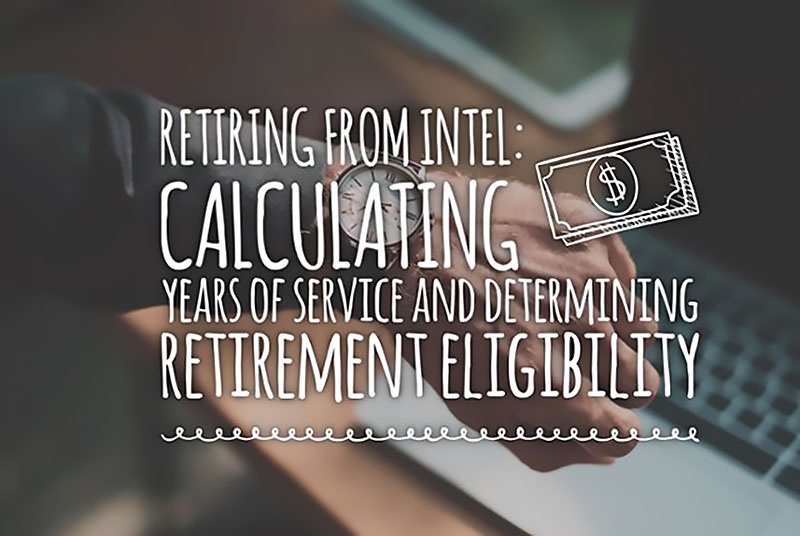Not everyone leaving Intel, even if it’s their last job, officially retires from Intel. The company has very specific retirement eligibility rules and subsequent benefits accruing to official retirees. And, as with all Intel benefit plans, these benefits can be enormously valuable but are often complex and difficult to determine how they apply to your specific situation.
We help our clients in defining their benefits and then applying them to their individual situation as part of our retirement planning process, but here we want to lay out this part of the Intel retirement process for everyone. This series will attempt to do three things: Review when someone qualifies to officially retire from Intel; Illustrate how years of service at Intel are calculated, and then, in part two we will review the benefits accruing to Intel retirees.
As Intel’s 2017 Pay, Stock and Benefits Handbook (hereafter, simply the 2017 Handbook) states, “Understanding the retirement eligibility rules and how your retirement benefits work is essential to maximize the value these benefits offer.”
Let’s take a look.
Are you Eligible to Retire?
According to the 2017 Handbook, we can see there are two factors (resulting in three eligibility rules) in determining who qualifies to officially retire from Intel: your age and years of service. These two factors result in the following three requirements (pulled straight from the handbook on page 488), only one of which must be met to qualify as an official retiree:
- Age 65—Be at least 65 years old with no minimum years of service requirement (normal retirement age)
- 55 & 15—Be at least 55 years old and complete at least 15 years of eligible service
- Rule of 75—Satisfy the requirements of the Rule of 75, which means the combined total of your age plus your length of service (both calculated in completed, whole years) is equal to or greater than the number 75
Meeting any one of these requirements make you eligible to officially retire from Intel and participate in the following retiree benefits programs (again from page 488 in the 2017 Handbook).
- Intel Retiree Medical Plan (IRMP) and Intel Retiree Vision Plan
- Sheltered Employee Retirement Medical Account (SERMA) (if hired prior to January 1, 2014)
- Stock Acceleration (Rule of 75only)
- Pro-rated Retirement Contribution, QPB, and APB
However, each eligibility requirement interacts with the benefits in different ways, so our next step is determining years of service.
Calculating Years of Service
This is straightforward for an employee with no breaks in service. However, it gets more complex for anyone who left Intel at some point in their career and then was rehired. Here we will cover both scenarios. But first, let’s go back to the 2017 Handbook and see how a year of service is defined:
A year of service is defined as a period of 12 consecutive months during which you receive pay from Intel, including normal periods of absence for vacations, holidays, and temporary approved leaves. For purposes of determining your initial eligibility, you will receive credit for a year of service after you have completed 365 days without a break in service of 12 months or more. If you leave Intel but return to service within a 12-month period, you will be considered to have been in service with Intel continuously during the period of absence. If you leave Intel and return to service within five years, your previous eligible service will count towards the Rule of 75 and 55 + 15 Intel retirement eligibility rules.
From this we learn two things: 1) an absence or break from Intel of 12-months or less effectively does not affect your years of service, and 2) for a break between 12 months and up to 5 years, prior service will still count towards the Rule of 75 and 55 + 15 retirement eligibility.
Let’s look at two examples.
Example #1: Continuous Employment
- Age: 65
- Start date: Jan. 01, 1995
- Retirement date: Jun. 30, 2016
- Years of Service = 21 (21 full years + 6 months)
- Retirement Eligible?
- Age 65: Yes
- Rule of 75: Yes (65 + 21)
- 55 + 15: Yes
Example #2: Break-in-service
- Age: 55
- Start date: Jan. 01, 1993
- Break in Service: Feb. 01, 2005 to Mar. 01, 2007
- Retirement date: Mar. 30, 2017
- Years of Service = 20 (10 years initial tenure + 10 years current tenure)
- Retirement Eligible?
- Age 65: No
- Rule of 75: Yes (55 + 20)
- 55 + 15: Yes
At this point, you should have a good overview of just who is eligible to officially retire from Intel and more clarity around calculating your own years of service. What’s left is the fun part—the benefits of being an Intel Retiree. Initially, the objective was to cover the all three parts in one article. However, true to form with a complicated topic, the post is getting long (at least we’re only at ~800 words vs. 651 pages (!) in the 2017 Handbook). So, we’ll pick back up in part two and cover the benefits of meeting the official Intel retirement requirements and introduce an Excel tool that will help you calculate your years of service, retirement eligibility, and your retirement benefits.
Stay tuned and make sure to sign up for the blog so you won’t miss part two.
Click here for disclosures regarding information contained in blog postings.



